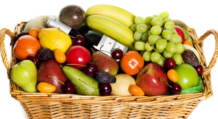Bethany Bachmann, Nutrition and Health Education Specialist, Perry County, University of Missouri Extension*
When you hear the word salad, what comes to mind? More than likely it is something plain and boring that you have to force yourself to eat. But it is time to move beyond the plain iceberg lettuce and ranch dressing salads or the salads overloaded with unhealthy toppings that we commonly think of. These days everyone is putting a twist on salads, and what better way to get our children to eat more fruits and vegetables than by creating a colorful and flavorful salad for lunch or dinner.
The 2015 Dietary Guidelines recommend 4½ cups (9 servings) of fruits and vegetables each day for a 2,000-calorie diet. So why not make a salad to help meet this recommendation? Here are a few tips to make a salad that will appeal to even the pickiest eater:
- Make it colorful! Skip the iceberg and opt for spinach or another dark leafy green. Dark leafy greens supply a tremendous amount of nutrients including vitamin A, vitamin C, vitamin K, iron, calcium, fiber and many others. Add in some carrots, red bell peppers, tomatoes, blanched asparagus, beets or any other vegetable to add color and you get additional nutrients critical for maintaining eyesight, bone health and digestive health.
- Salad isn’t just for vegetables anymore! Many restaurants are now shaking salads up by adding a variety of fruit to the mix, so why not make your own creation? Try adding in apples, citrus segments, grapes, strawberries or blueberries to your plate of colorful vegetables. Just like many vegetables, fruits contain antioxidants which can help protect against certain forms of cancer as well as reduce levels of LDL or bad cholesterol. Try to avoid or limit the amount of dried fruits you add to your salad, such as dried cranberries or blueberries. These often have added sugars that can up the calorie content of your meal.
- Go a little nutty! Walnuts are a great addition to any salad. These heart-healthy nuts contain the most omega-3 fatty acids of all the nuts. Omega-3 fatty acids can improve cardiovascular health and improve cognitive function. To add a bit more flavor, toast the walnuts in a dry pan or in the oven until you can just start to smell them. If you aren’t a walnut fan, add in some almonds, but remember to limit the amount you use. Almonds are a healthy nut to choose but are also very high in calories.
- Add some protein! Protein takes longer to digest, so it keeps us full longer. Protein is also needed for healthy muscles. Eggs, lean meat, beans, nuts and cheese (in limited quantities) are easy ways to add protein.
- Find a healthier dressing that works for you! There is now quite a variety of light dressings and vinaigrettes to choose from. Vinegar-based dressings typically have less fat and calories than creamy dressings. Oil and vinegar is a healthy choice — the healthy fat from the oil helps your body to absorb some of the vitamins from the salad — but you should still limit the amount you use.
- You can easily make your own salad dressing by using 2 parts olive oil to 1 part acid (balsamic vinegar, red wine vinegar, cider vinegar, lemon juice or a combination of these). Add seasonings that you enjoy (oregano, basil, pepper, garlic). To make the dressing thicker, you can add a small amount of Dijon mustard or plain Greek yogurt. Experiment with the amounts until you find a combination that you enjoy.
A salad can be the perfect meal for a hot summer day — you don’t have to turn on the stove to make a healthy, delicious meal. If you have a garden, most of the meal can be taken right out of your backyard. You can also visit your local farmer’s market to see what is fresh and in season. You may just find something new to add to your delicious creation.
Whether you are preparing dinner for your family, entertaining a crowd or grabbing something on the run, choosing a salad can be a simple way to satisfy recommendations for fruit and vegetable intake. However, be smart about what you add to it because salads overloaded with cheese, bacon, croutons and dressing can ruin the intention to eat healthy.
*With contributions from Melissa Bess, former Nutrition and Health Education Specialist & Tammy Roberts, Nutrition and Health Education Specialist, Bates County, University of Missouri Extension




